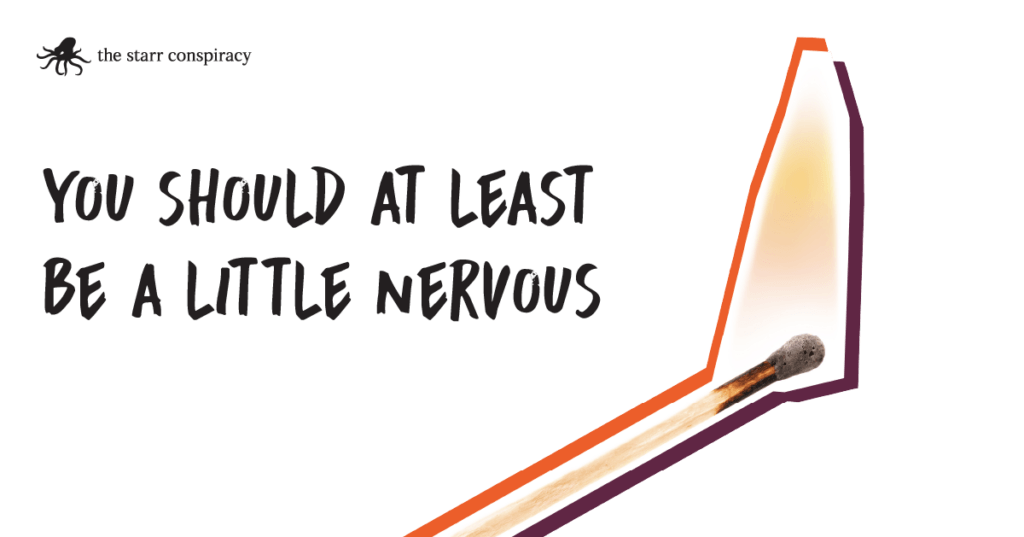Bret Starr, co-founder, CEO, and partner (whew!) of The Starr Conspiracy, is fond of saying that if you’re reframing your brand, you should be at least a little nervous when you send your new look and message out into the wild. Otherwise, you haven’t gone far enough. You might just as well have stayed with what you had or gone with some soothingly similar variation on that same theme. And look where that got you. But I digress.
An interesting characteristic of discomfort and nervousness is that they’re both caused by friction. At The Starr Conspiracy, we like friction. It means things are moving. More than that, friction generates heat, and heat leads to transformation. You know — ice to water to vapor.
As an agency that helps businesses accelerate positive results in their employee, customer, and shareholder experiences, we’re big on friction and heat. We’re big on seeing sparks fly. They’re a sign that things are heating up and differences and new ideas are getting flung around, hammered out, and nailed down. Friction and sparks mean a new view of the future is being forged and reality is about to have a new shape.
Danger, Will Robinson: Transformation Ahead
One thing about sparks is that they fly in all directions. Our clients see them from their perspective. We see them from ours. If you’re fortunate in this business (or in any other line of work, really), you create sparks that not only fly in your own direction, but that set something inside of you on fire or illuminate a new way of thinking or seeing.
When you work intimately with anyone to help them achieve change, no matter your occupation and certainly in marketing that seeks to get down to the bone, you learn from your customer (just as you learn from your client, coworker, patient, child, spouse, student — whomever). If you don’t get a little bit of a headache and don’t cause at least a few sparks, you haven’t done the work required to dig down deep and understand their world. It truly is a two-way street, if you’re fortunate and stay open to the possibilities.
Working with one client at The Starr Conspiracy helped me transform the quality of my conversations — with anyone, about anything. I caught a spark that reminded me of and helped me hone a practice to “have the difficult conversation now” (because it won’t get easier later). It also enlightened me to come into every conversation realizing that we each see only our singular stripe of the giant beach ball that we’re all standing on. We think the whole world is the color of our stripe because it’s all we can see — until the ball turns and we tumble into some new landscape.
No More Either-or About Mental Health
From another client, I caught a spark that changed how I view mental health (and this from a former journalist who spent a few years covering the world of behavioral health for a major daily newspaper). Working with this client, I was on fire with the concept that mental health isn’t the opposite of mental illness. Instead, on any given day, we all have a touch of both — mental wellness and whatever you want to call the other thing: mental illness, mental unhealth, whatever. I loved the concept that mental fitness is just like physical fitness. Just as our physical body relies on innumerable connections and interactions among an astronomical number of parts, our “mental body” is also composed of a huge number of working parts. And just as with our physical body, most of the parts in our mind are usually operating at their full potential. Some other parts are often operating at sub-optimal (but still OK) performance. And sometimes, sadly, a part or two of our “mental body” is so out of whack or broken that it leaves us a side dish shy of a combination platter.
The concept of two spectrums vs. an either-or model of mental wellbeing has helped me navigate my own daily journey with greater balance. And it’s been a thrill to think we’re helping persuade employers to take the same can-do attitude toward mental wellbeing as they’ve taken for years toward physical wellbeing — to invest in programs that help employees improve all of the parts of their mental body, not just the broken parts, and to not wait until it’s time time to contact the EAP or a therapist to tend to the mental body.
Of Storytelling and More
From another client, I caught a spark that has helped me hone my writing through better storytelling. I thought I had this stuff down cold. After all, I have a Master’s degree from the Columbia School of Journalism and more than four decades of professional non-fiction writing under my belt. But it was incredibly helpful to learn the power of a compelling story in any kind of communication, whether you’re presenting with a slide deck or seeking to persuade someone about anything in an email, sales sheet, blog post, or ebook.
From yet one more client of The Starr Conspiracy I’ve gained a fresh and clear understanding of the differences between mentoring and coaching (no, they’re not synonymous). Learning the difference and putting the knowledge into practice has helped me in all parts of my life. It’s improved how I support my colleagues at the agency, for sure. But it’s also helped make me a more effective yoga instructor, both in group classes and in private sessions, where I work with people on everything from alleviating lower back pain to going deeper into their poses.
And you know all that stuff about employee engagement — those high-falutin’ sentiments about connecting employees with a company’s vision or mission? I offer as a clear example this commonly quoted and florid statement from Jack Welch, former chairman of GE: “It goes without saying that no company, small or large, can win over the long run without energized employees who believe in the mission and understand how to achieve it.” What in the hell does that even mean? I’ve been moved instead by the viewpoint of another of our clients. They say employee engagement comes when people are proud of the work they do and proud of the company they work for. Drop the mic. It can be that simple. As someone who believes in the power of purpose, I found it refreshing to hear such a grounded approach to how to truly unite people behind a vision. It’s what we teach or maybe what we hope for in our children: that they simply be proud of what they do and who they do it for. Why not apply that in the workplace?
Enjoying the Thermodynamics
When it’s all send and done, it’s about enjoying the ride — the court and spark, the fire and transformation. Doing that, as part of humanizing brands and accelerating positive change in the employee, customer, and shareholder experience demands taking things down to bare metal. It requires disregarding the shiny paint job and fancy geegaws (for now) and instead, rolling up your sleeves and digging in to see what’s really going on in there. That’s when the sparks fly and catalytic change can occur.



